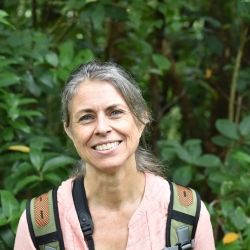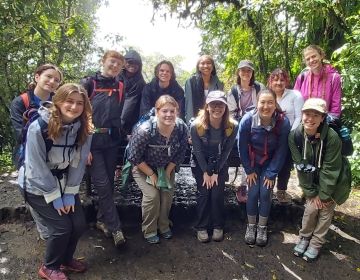Sustainability and the Environment: "La Carpio and the River of Dreams"
It was only a few days in, and already the adventurers were learning that the new world they'd come to was a land of contrast. They learned about a small town called La Carpio, a neighbourhood established by Nicaraguan immigrants that sat adjacent to a landfill and lay between two rivers-- a town surrounded by pollution and the mark of humankind, but a witness to great efforts to manage and undo the damage done to the natural environment.
On Thursday, the 11th of February, the adventurers drove out of Alajuela on their big bus and put on hard hats and trendy vests to go check out a brand new water treatment plant near La Carpio on the Rio Torres.
Emily has found her natural style
The Rio Torres is one of the most polluted rivers in the country, but the new water treatment plant just upstream of La Carpio hopes to purify the river and begin to erase the impact humankind has had on this important ecosystem.
Here's Adam explaining how this complicated machinery works
Since the plant is so young, at this point it is only removing solids from the water. In five years, however, they plan to be removing sediments and implementing aeration. They also hope to increase the amount of water being treated. As it stands right now, 4.6 million kilograms of solid waste is removed per year.
According to the environmental monitor, the plant is fully automated, and really only needs one person to run it, Skynet style. Since these guys are too smart to allow a Terminator-type scenario to get ahold of their water treatment plant, the plant actually employs 54 people. It took 600 people to build the plant (we don't have robots that can do that yet), and 70% of that 600 came from La Carpio. However, only 2 of the 54 employees are from La Carpio.
There's that contrast we were talking about.
The adventurers learned that, while the water treatment plant is a great development, fundamentally changing the culture at a national level is the only real solution. Education, legislation, and personal responsibility are the keys to reducing the pollution of the natural environment.
Don't throw your water bottle in the street, okay? And cut it out with the plastic bags already.
Meg is stoked to emerge from the gas chamber into sweet sweet sunlight
Chandler and Emily forgot how nice Outside really was
Well the adventurers breathed a few clean gulps of air, and then they loaded back up onto the bus and headed for La Carpio.
They were aiming for the sanitary landfill on the edge of the neighbourhood, to see what happened to their garbage when they threw it out. I know a landfill doesn't seem like a good solution to the trash problem, but these "sanitary" landfills are actually an improvement on the alternatives. When there aren't sanitary landfills (landfills that are carefully planned, organised, and managed), people just kind of dump their trash wherever they feel like it.
Even with the presence of the EBI sanitary landfill, illegal dumping still occurs rampantly. Even driving into La Carpio, with the legal landfill only a handful of miles down the road, the adventurers witnessed some illegal dumping into a pit on the edge of town.
A town on the edge of an illegal dump
The adventurers drove through La Carpio and into the gates of the EBI sanitary landfill. The first thing the noticed was wind-borne litter (plastic bags mainly, but some cardboard and paper) getting carried off beyond the fences of the landfill.
The landfill has nets and fences up to attempt to catch some of the wind-borne litter, but a good percentage of it escaped the confines and drifted off into the world beyond, turning in the wind like an evil kite, dead-set on killing a turtle someday.
A masked hero attempts to retrieve the wind-borne litter
The adventurers wandered past the litter fences and made their way into the landfill. Sam the TA was looking around for a giant pit of garbage that he'd seen here last semester, but he quickly realised that in only a few months, it had turned into the giant mountain of garbage that lay before him. This landfill is already over capacity.
A bulldozer fills in for WALL-E
The landfill funnels the water that escapes from the garbage and purifies it as best it can, then releases it into the river
Hannah seems to be incredulous about the amount of garbage that has made it here. Either that or she's getting garbage dust blown into her face by the crazy-strong wind. Probably some of both.
Leah's got a positive attitude about it
The EBI landfill receives 1200 tons of garbage per day. From 6am to 11pm, the garbage doesn't stop. With this landfill reaching its capacity, the company will soon have to find another location for a new sanitary landfill, most likely on the edge of a town much more developed than La Carpio.
Leah has found a clever way to block her face from the garbage dust that the wind is throwing at her
We really need to come up with a better way to make less trash you guys
Well the adventurers brushed themselves off, blew their noses, and spilled back onto the bus. Behind them, the men in orange continued to pick the plastic bags from the fences before they blew away.
The adventurers made their way into La Carpio, with the intent of checking out the Rio Torres, just downstream of the water treatment plant. Even though the plant removed the big solids from the water, the river was still in pretty bad shape by the time it made it through La Caripo. The adventurers spotted plastic bags, furniture, and dead pets floating down the river and caught on rocks amid the rapids. Soap suds turned the river white. It was pretty rough stuff.
A bridge that allowed the residents to go to work across the river has collapsed. Unable to cross the mangy river and scale the eroding bank, most residents have had to give up their jobs.
A young resident of La Carpio drinks from a water pipe on the bank of the river
This is where the fundamental cultural change is really necessary. Education and personal responsibility have to combine to break the habit of dumping trash into the river. Just because the river carries it from your sight doesn't mean it's gone. Sanitary landfills have to replace casual river trash disposal, and eventually something else will have to replace sanitary landfills. It's not a problem that will go away until we solve it.
Mabel tested the water to compare to other water sources they would visit along their travels-- she was careful not to accidentally fall in-- and then the adventurers left the tragic river, and walked back into La Carpio.
That afternoon, the adventurers met with an old friend of Karen's named Alba Luz, a long-time resident of La Carpio who emigrated from Nicaragua into Costa Rica and the small immigrant neighbourhood.
Alba Luz and her husband in their home on the edge of the landfill
Alba Luz told the students about her journey from Nicaragua as well as how the neighbourhood has changed in the years since the landfill established itself on the edge of the community. She explained that the town is paid a small fee for allowing the landfill to exist at the edge of the community, but it is a pittance. She also contests the claim that garbage delivery begins at 6am; she claims that she is woken up at 3am every morning as the trucks begin to come.
Alba is dubious of many of the promises that EBI, the company that runs the landfill, has made to the community. She feels that because La Carpio is such a poor and oppressed community, they have very little say in their own future and their rights are constantly endangered. She is optimistic about her community however; she says that the women in La Carpio have become empowered, and the neighbourhood has a very strong artistic identity. The houses are colourful, and there is local art flanking the dirty streets. Another land of contrast.
The adventurers cement their visit to La Carpio with a photograph
As the adventurers rolled away from La Carpio, the landfill, the water treatment plant, and the two rivers, they mulled over everything that they had seen. They thought about the amount of garbage that is trucked into the landfill everyday, and the debris and litter that they watched flowing down the river.
But the treatment plant is young, and soon there will be another landfill. They were excited to begin their journey of learning how to, as humans, find a way to fit into the natural world with more respect and grace.
That's what Sustainability is all about.
Related Posts
Costa Rica vs. Argentina: Which is Better for Study Abroad?
Imagine yourself sipping mate in a bustling Buenos Aires café or lounging peacefully in a hammock overlooking Costa Rica's lush rainforests. These contrasting scenes represent just a glimpse of the... keep reading
Happy Earth Day: Today and Every Day
Happy Earth Day! Every April 22, this global event comes around to remind us how precious our planet is, what sustainable efforts we can make to protect Earth, and that... keep reading
Top 10 Study Abroad Volunteer Opportunities with CIEE
Have you ever wondered if you could volunteer abroad? Perhaps you're looking into study abroad programs that provide international volunteer opportunities. If you’re itching to study abroad and truly make... keep reading



